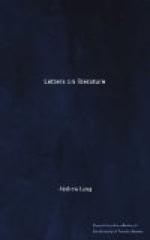These books are extraordinarily rare; you are more likely to find them in some collection of twopenny rubbish than to buy them in the regular market. Bryant’s “Poems” (Cambridge, 1821) must also be very rare, and Emerson’s of 1847, and Dr. Oliver Wendell Holmes’s of 1836, and Longfellow’s “Voices of the Night,” 1839, and Mr. Lowell’s “A Year’s Life;” none of these can be common, and all are desirable, as are Mr. Whittier’s “Legends of New England” (1831), and “Poems” (1838).
Perhaps you may never be lucky enough to come across them cheap; no doubt they are greatly sought for by amateurs. Indeed, all American books of a certain age or of a special interest are exorbitantly dear. Men like Mr. James Lenox used to keep the market up. One cannot get the Jesuit “Relations”—shabby little missionary reports from Canada, in dirty vellum.
Cartier, Perrot, Champlain, and the other early explorers’ books are beyond the means of a working student who needs them. May you come across them in a garret of a farmhouse, or in some dusty lane of the city. Why are they not reprinted, as Mr. Arber has reprinted “Captain John Smith’s Voyages, and Reports on Virginia”? The very reprints, when they have been made, are rare and hard to come by.
There are certain modern books, new books, that “go up” rapidly in value and interest. Mr. Swinburne’s “Atalanta” of 1865, the quarto in white cloth, is valued at twenty dollars. Twenty years ago one dollar would have purchased it. Mr. Austin Dobson’s “Proverbs in Porcelain” is also in demand among the curious. Nay, even I may say about the first edition of “Ballades in Blue China” (1880), as Gibbon said of his “Essay on the Study of Literature:” “The primitive value of half a crown has risen to the fanciful price of a guinea or thirty shillings,” or even more. I wish I had a copy myself, for old sake’s sake.
Certain modern books, “on large paper,” are safe investments. The “Badminton Library,” an English series of books on sport, is at a huge premium already, when on “large paper.” But one should never buy the book unless, as in the case of Dr. John Hill Burton’s “Book-Hunter” (first edition), it is not only on large paper, and not only rare (twenty-five copies), but also readable and interesting. {7} A collector should have the taste to see when a new book is in itself valuable and charming, and when its author is likely to succeed, so that his early attempts (as in the case of Mr. Matthew Arnold, Lord Tennyson, and a few others of the moderns) are certain to become things of curious interest.
You can hardly ever get a novel of Jane Austen’s in the first edition. She is rarer than Fielding or Smollett. Some day it may be the same in Miss Broughton’s case. Cling to the fair and witty Jane, if you get a chance. Beware of illustrated modern books in which “processes” are employed. Amateurs will never really value mechanical reproductions, which can be copied to any extent. The old French copper-plate engravings and the best English mezzo-tints are so valuable because good impressions are necessarily so rare.




